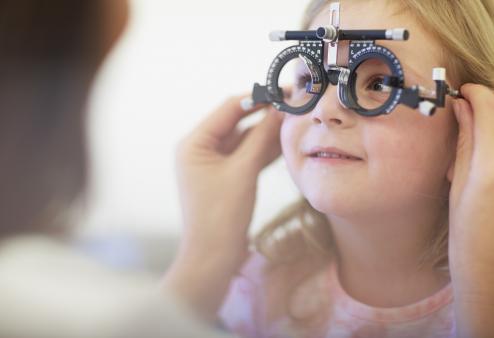
Pink eye and the common cold go hand in hand — except when the sniffles aren’t to blame for your inflamed eyes.

Blazing red eyes. Sticky, crusty, puffy eyelids. The overwhelming urge to scratch your eyeballs or douse them with cool water. You guessed it—pink eye.
The mere thought can set off a mild panic. After all, mom always told you to steer clear of anyone showing telltale signs of pink eye—especially in the height of cold season.
The medical term for pink eye is conjunctivitis. It is an inflammation of the sensitive, thin layer of tissue (called conjunctiva) that lines the inside of your eyelids and covers the whites of your eyes.
It’s true that one of the most common causes behind unsightly pink eye is adenovirus — the same bad-guy germ that causes colds and sore throats. But there’s more than one type of pink eye, and not every form is contagious or the result of a cold bug, says Julie Schaefer, O.D., an optometrist at South Florida Regional Eye Associates, located inside an America’s Best Contacts & Eyeglasses in Miami.
Here’s a closer look at a few surprising causes of pink eye—and what you can do to soothe the red away.
Eye exams are an essential part of your health care routine. Book an appointment with your America’s Best optometrist today! Click here to find a time that fits your schedule.
Surprise Pink Eye Culprit #1: Your Babysitter
Our homes, cars, and work spaces are teeming with bacteria. Not all of them are bad, of course. But a few of the more serious strains—such as the ones that cause ear, skin, and sinus infections, as well as meningitis, strep throat, and serious respiratory diseases—are leading causes of bacterial conjunctivitis.
(Biology fans might recognize the names of some of these bacteria: Staphylococcus aureus, Streptococcus pneumoniae, Haemophilus influenzae.)
Germs may migrate to your eyes from bacteria in your nose, sinuses, or ears, if you have an infection in any of those places. And like viral forms of pink eye, bacterial conjunctivitis is easily transmitted.
“Anyone can get the infectious type of pink eye,” says Dr. Schaefer, “but certain people are at greater risk.” In particular, anyone who spends a lot of time around kids, she says. The Centers for Disease Control notes that bacterial conjunctivitis is more common in kids than adults, and it is a leading cause of kids missing school and day care.
But in one 2017 study from the University of California, San Francisco, which involved more than half a million cases of pink eye across the United States, researchers found that women and men in their 20s and 30s were also prone to pink eye—presumably because their children brought it home.

Surprise Pink Eye Culprit #2: The Family Pooch
Pet dander, tree and grass pollen, mold, and dust mites are other sneaky sources of allergic conjunctivitis. Smog, swimming-pool chlorine, and various chemicals and particles in the air and water can also irritate your eyes. This includes car exhaust fumes and tobacco smoke.
Itching, burning, watery eyes, and sensitivity to brighter lights are telltale signs of allergic conjunctivitis. Sticky, crusty eyelids are much more common with bacterial conjunctivitis.
And here’s the tricky thing: You don’t necessarily have to be bothered by seasonal or respiratory allergies for any one of those allergens to affect your eyes, although you’re much more likely to be stricken with allergic conjunctivitis if you do have hay fever or asthma.
The good news (for the rest of your family, anyway): Allergic conjunctivitis isn’t contagious.
Surprise Pink Eye Culprit #3: Your Contact Lenses
If you pick up pink eye germs on your hands and then insert or remove your contact lenses without washing your hands, you’re inviting the germs to settle in. Ditto for applying eye makeup.
“I find that many cases of conjunctivitis end up being the result of misusing contact lenses,” says Dr. Schaefer.
The lesson: It’s important to follow your optometrist’s instructions for cleaning and sanitizing your contact lenses. And if you are recovering from a bout of pink eye, switch over to glasses. When your eyes have cleared, start with a fresh pair of contact lenses, a new storage case, and new cleaning solutions, too.
2 Simple Ways to Soothe Pink Eye
Even though conjunctivitis—of any kind—is no fun, it’s generally harmless. In fact, pink eye often clears up on its own over the course of a few days or a week.
Still, Dr. Schaefer says it’s a smart idea to call your eye doctor any time your eyes are irritated for more than a few hours, to get to the root cause.
“You only have one set of eyes, so you don’t want to risk permanent damage to your vision by not getting the proper treatment,” she says. “Not all cases will need a prescription, but only your eye doctor can determine if this is the case.”
These home remedies can bring much-needed relief from pink eye symptoms:
Warm and cool compresses. Gently pressing a cool, damp washcloth over your eyes for a few minutes can help ease the burning, gritty feeling. A warm cloth can bring quick relief for the sticky discharge.
Over-the-counter eye drops. Artificial tears can ease the dryness that often accompanies viral conjunctivitis. And eye drops with an antihistamine can help those with allergic conjunctivitis. There are several options at the pharmacy, so get a recommendation from your eye doctor first.
Pink Eye Symptoms
Pink eye can be painful and irritating when the infection strikes. In addition to the whites of the eye turning pink or red, a person can also expect to have swollen eyelids, lots of tearing, drainage, crusty eyelids and sensitivity to bright light.
Treating Pink Eye
Because it is highly contagious, pink eye can spread easily and quickly to others. This is usually due to improper hand washing after touching the area around the eye. It can also spread by using the same towel, pillowcase or other object that a person with pink eye has used. Children who have pink eye should remain out of a daycare or school setting.
Long-Term Effects. While pink eye can be irritating, it is rarely serious and will not affect long-term vision as long as it is detected and treated promptly. In some cases, if a person becomes a chronic sufferer of pink eye, it can indicate an underlying illness in the body.
Treatment. If pink eye is suspected, make an appointment with your eye doctor. The optometrist can generally make the diagnosis based on symptoms but in some cases may need to conduct a quick eye exam to determine the cause. Prescription eye drops can be prescribed to alleviate the infection and provide relief.



